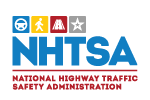Traffic Records
Additional Resources
NHTSA works to ensure that complete, accurate, and timely traffic safety data are collected, analyzed, and made available for decision-making at the national, state, and local levels. Analyzing reliable and accurate traffic records data is central to identifying traffic safety problems and designing effective countermeasures to reduce injuries and deaths caused by crashes. NHTSA promotes a comprehensive, systematic approach to assessing the performance of traffic records systems, and works with a several partners in the public and private sector, including national non-profit organizations, to achieve this vision and mission.
NHTSA’s National Driver Register and Traffic Records Division provides coordinated guidance, outreach, best-practices, and training and technical assistance designed to improve the timeliness, accuracy, completeness, uniformity, integration, and accessibility of state crash, driver, vehicle, roadway, citation and adjudication, and injury surveillance databases. The Traffic Records Team is tasked with helping states improve their traffic safety data collection, management, and analysis capabilities through evaluation, training, and technical assistance.
Traffic Records Assessment
NHTSA’s assessments are peer evaluations of State traffic records system capabilities. Using the online State Traffic Records Assessment Program (STRAP), independent subject matter experts from State, local, and other areas examine State responses to a uniform set of questions and rate the responses against the ideal set out in the Traffic Records Program Assessment Advisory. The final report includes these ratings, recommendations, and considerations that the States may consider in working to improve their traffic records system performance.
- Traffic Records Program Assessment Advisory
- Procedures Manual, rev. 10/2015
- Upcoming Assessments, rev. 5/2015
- STRAP icons and color codes
Crash Data Improvement Program (CDIP)
NHTSA’s CDIP technical assistance program examines the quality of a State’s crash data and provides the State with specific recommendations to improve the quality, management and use of that data to support safety decisions. This program is free to the States and made available on a first-come, first-served basis given available funds.
- CDIP Application (coming soon)
- CDIP Guidelines, rev. 2015 (coming soon)
GO Teams
NHTSA’s Traffic Records GO Team program is designed to provide resources and assistance to State traffic records professionals as they work to better their traffic records data collection, management, and analysis capabilities. GO Teams are small groups of one to three subject matter experts designed to help States address traffic records issues.
Model Minimum Uniform Crash Criteria (MMUCC)
The Model Minimum Uniform Crash Criteria (MMUCC) Guideline, Fourth Edition (2012), is a voluntary guideline designed to help States determine what crash data to collect on their police accident reports (PARs) and what data to code and carry in their crash databases. To assist States in evaluating their consistency with MMUCC, NHTSA and GHSA have developed a methodology for mapping the data collected on PARs and the data entered and maintained on crash databases to the data elements and attributes in the MMUCC Guideline. This methodology is intended to standardize how States compare both their PARs and their crash databases to MMUCC. The process recognizes that while State data systems often use different terminology and formatting, different data sets often can be mapped to the recommended MMUCC data elements and attributes.
- Mapping to MMUCC: A Process for Comparing Police Crash Reports and State Crash Databases to the MMUCC (DOT-HS-812-184)
- Mapping Tool [Excel *.xlsx]
Data Standards
MMUCC | FARS | MIRE | NEMSIS | NIEM | MIDRIS | HPMS
